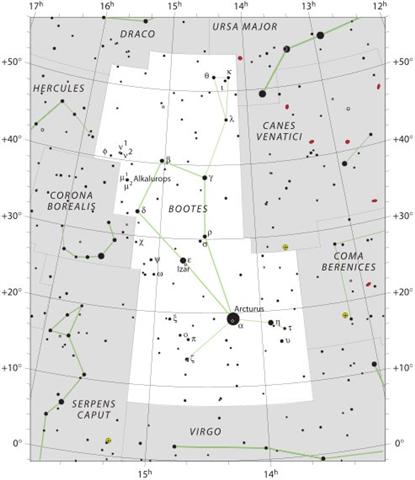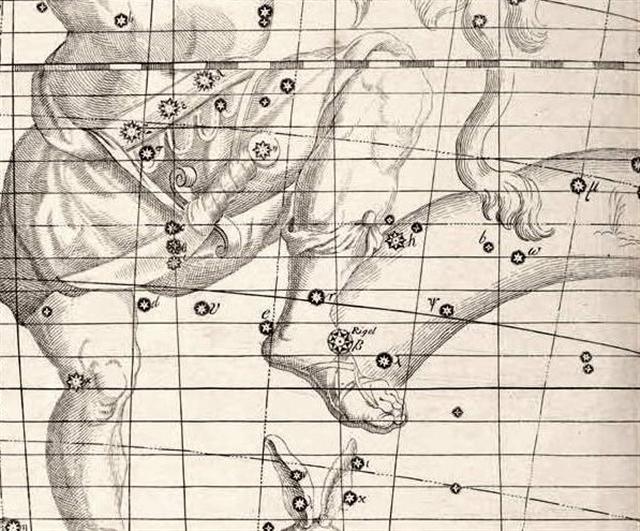4. We ought to add some stars to our list. There are 4 with letters high up at the left hand of Bootes, which holds the leash to his dogs (θ, ι, κ, λ). Then there are 3 low down in the 14th hour, at his left foot (η,τ υ). Furthermore, there are ρ and σ at his waist, and his right leg holds ζ, π, ο, ξ.  Let's take it in two steps, first those 3 which belong in the previous hour:
"Muphrid, Mufrid, and Mufride, of the Palermo and other catalogues, is from Ulug Beg's Al Mufrid al Rāmih, the Solitary Star of the Lancer, and inexplicable unless on the supposition that it formerly was regarded as outside of the figure lines. Kazwini called it Al Rumh; and Al Tizini, with Al Nasr al Dīn, more definitely Al Rumh al Rāmih, the Lance of the Lancebearer, although inappropriately, for they designated its position as on Al Sāk, the Shin-bone, and it thus appears as Saak in som lists; but as the figure is now drawn η lies above the left knee. It seems to have been included with Arcturus in the Euphratean Sib-zi-anna. With υ and τ in the feet, it was Yew She Ti in China, the Officer standing on the right hand of the emperor." (Allen) I remember the left shin-bone of Orion and the star at the top of his sword handle, η Orionis, see at Hua Reva
... Ian Ridpath (http://www.ianridpath.com/startales/startales3.htm) does not comment upon the 'erigated' sword handle. His statement that Ptolemy had the beginning of the River at λ Eridani does not necessarily imply Ptolemy meant its water flowed away from the left foot of Orion, it could be only a reference to where the constellation Eridanus began. However, Ptolemy may have left us a Sign in mentioning not only β Orionis but also λ Eridani as belonging in the River, with β Eridani perhaps like a hua reva, in which case Eridanus indeed would run towards stars with lower right ascension numbers - time would run withershins. Notably the left shin of Orion is uplifted ... Also Benetnash is denoted by the letter η. Wikipedia: Eta (uppercase Η, lowercase η; Greek: Ήτα Ēta) is the seventh letter of the Greek alphabet. Originally denoting a consonant /h/, its sound value in the classical Attic dialect of Ancient Greek was a long vowel ... In the system of Greek numerals it has a value of 8. It was derived from the Phoenician letter heth:
Letters that arose from Eta include the Latin H and the Cyrillic letter И ... The letter shape [of heth] ultimately goes back to a hieroglyph for 'courtyard',
(possibly named hasir in the Middle Bronze Age alphabets, while the name goes rather back to hayt, the name reconstructed for a letter derived from a hieroglyph for 'thread':
For a discussion of the moe type of glyph and the explorers, see the Moe chapter.
| ||||||||||||||||||||||||||||||||||||||||||||||||||||||||||||||||||||||||||||||||||||||||||||||||||||||||||||||||||||||||||||||||||||||||||||||||||||||||||||||




 .
.
